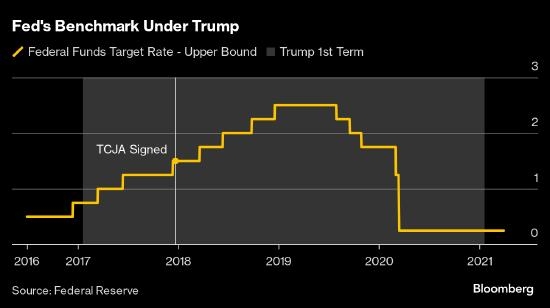
Federal Reserve Chairman Powell said he wanted to wait and see what policies the incoming Trump administration would implement, and then the Fed could predict what that would mean for the economy.
“There is currently nothing to simulate,” Powell said at a press conference on November 7. “We do not guess, speculate, or assume.”
This is in stark contrast to the Fed's reaction to Trump's election victory in 2016, as confirmed by the minutes of the Fed meeting. A month before Trump took office, Fed staff began to predict that fiscal policy would likely boost economic growth based on the assumption that Trump's promised tax cuts would pass, and that this growth would be partially offset by rising interest rates. Several Fed policymakers, including Powell, also incorporated changes in fiscal policy into their forecasts at that time.
“It looks like there may be more expansionary fiscal policy in 2017,” Powell, then a Fed governor, commented when submitting forecasts at the Federal Open Market Committee meeting in December 2016. “Therefore, I followed the staff's baseline assumption, assuming that the personal income tax cut is equivalent to 1% of GDP.”
He went on to say that he had adjusted his interest rate forecast, expecting three rate hikes of 25 basis points in 2017 instead of two.
The Fed spokesperson declined to comment.
Given that Trump's policies are likely to reignite price pressures and the Fed officials are still struggling to complete the most difficult battle against inflation in 40 years, Powell's extraordinary caution compared to 2016 is striking. To what extent the Fed can further lower rates depends, to some extent, on how they view the impact of various factors such as taxation, tariffs, and immigration policies on the economy.
Former Fed governor and professor of economics at the University of Chicago Booth School of Business Randall Kroszner said that the “work against inflation is not yet fully completed,” while deregulation and business-friendly tax policies could boost the economy. He noted that as the economy improves, they will likely follow a “shallower” path for interest rates in the short term.
Political risk
For central bank governors who have previously clashed with the government's tax-cut policies, how and when to adjust monetary policy around fiscal stimulus is fraught with political risk. If they raise borrowing costs too early or too much to offset the impact of tax cuts, they may face criticism for being at odds with government policy. But if they raise rates too little or too late, inflation could heat up as it did in 2021.
It proved difficult to accurately predict the impact of Trump's policy proposals eight years ago. The Federal Reserve ultimately began lowering rates in July 2019 in response to a manufacturing slowdown and an inflation rate below the 2% target, just 19 months after Trump's signature tax cut plan was passed.

For former Fed governor Laurence Meyer, who experienced the Bush administration's 2001 tax cuts, the Fed's current response should be strictly limited to the staff level.
Meyer said they should conduct various simulations to understand how the economy would perform under tax cuts, “policy should not be based on situations where we do not know what will happen.”
However, others are concerned that if the Fed waits too long to respond, it may make mistakes. Trump's renewed promise of tax cuts, coupled with Republican control of both houses, makes it a reliable prediction that his administration's first-term tax cuts will be extended.
Several Wall Street banks have already taken action. Since Trump's election victory, economists at JPMorgan, Barclays, and TD Bank have reduced their forecasts for the number of rate cuts by the end of next year. Investors have also lowered their expectations for rate cuts in 2025.
Ellen Meade, a former senior policy advisor at the Fed and current professor of economics at Duke University, stated that regardless of how the Fed responds, what is truly needed is a routine process to address potential actions from the White House and Congress.
“Having a systematic process around how and when to incorporate expected fiscal measures into the baseline Tealbook forecast is crucial to ensure consistent treatment of future policies proposed by either party,” she said. The Tealbook she mentioned refers to the Fed's internal staff forecasts and strategy documents.
Search





